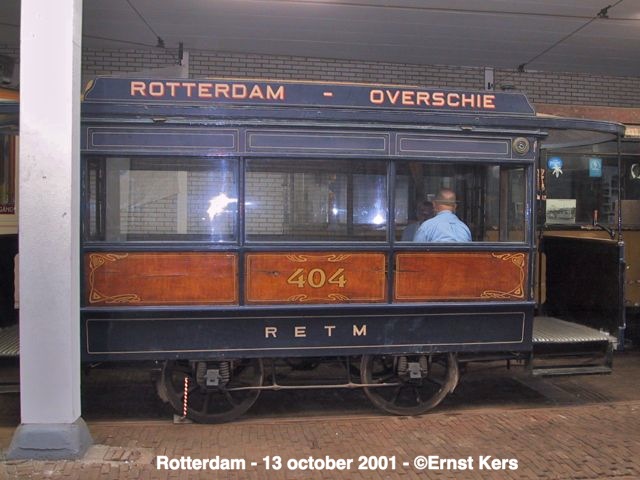Horse- steam- and motor trams
 Most horse tramcars in
Rotterdam were, like with the majority of the Dutch tram
companies, of a type designed by Beijnes of Haarlem. The RTM
did own about 100 tramcars of this type. Sixty-three cars
were acquired from Beijnes between 1879 and 1887. A number
came second-hand from other companies, others were
reconstructed out of horse-buses. They were also used on the
lines of the RTM outside Rotterdam.
Most horse tramcars in
Rotterdam were, like with the majority of the Dutch tram
companies, of a type designed by Beijnes of Haarlem. The RTM
did own about 100 tramcars of this type. Sixty-three cars
were acquired from Beijnes between 1879 and 1887. A number
came second-hand from other companies, others were
reconstructed out of horse-buses. They were also used on the
lines of the RTM outside Rotterdam.There were differences in size between the individual cars. Most tramcars did have three windows at each side, but a few had four. Most had seating for 16 passengers, but also smaller tramcars with seating for 12 did exist.
Six were converted in 1881 to be used with steam-trams to Schiedam while 50 were converted around 1906 into trailers for the electric tram. Others were sold to other tram companies. Also the SlTM and SdTM did use this type. The last horse-trams went out of service in 1925.
One did survive as museum horse-tram. This oldest still existing Dutch tramcar was built in 1880 and only came in 1915 from Amsterdam to Rotterdam to increase the capacity on the line to Overschie. Also an 1881 constructed tramcar which was converted into trailer with the number 327, still exists.
During the summer periods open cross-bench tramcars were used. The RTM did own about 40 of several types and sizes. Eight were converted in 1905 to be used as trailers of the electric tram. One of these, built in 1902 by Allan of Rotterdam, does survive as museum tram-car nr.188.
In 1881 the RTM did open the steam tram line to Delfshaven, which was extended one year later to Schiedam. For this a total of nine locomotives, seventeen closed trailers, three open cross-bench trailers and four closed vans were available. Eight locomotives came from Winterthur and one from Krauss.
Also the line to Overschie did start with steam traction. It was owned by the IJSM, a company which had plans for a large network of steam tram-lines. However only a few isolated lines were realized, one being the Overschie line. In 1890 the line went to the RTM which company did regauge it from 1067mm into 1435mm and changed for horse-traction. The RETM did retain the horses when the urban network was electrified, but in 1924-25 the horses were replaced by petrol engines. One articulated tramcar with petrol engines at both ends, was built (the first articulated in the Netherlands), but this was not very successful.
Five horse trams of the line to Hillegersberg were regauged to 1435 mm and equipped with two petrol engines: one for each direction. They did work on the line to Overschie until 1928 and were than replaced by buses.